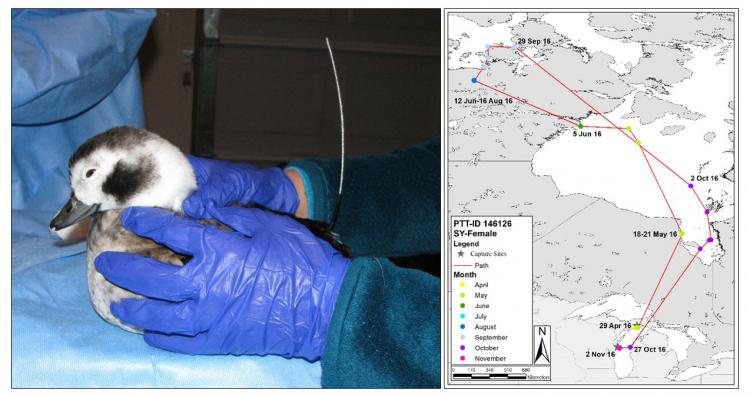Data suggest that long-tailed duck populations are in decline. As a result, efforts have been made to better understand their population distributions through satellite telemetry studies. In previous studies, radiomarked tracking of long-tailed ducks suggested little use of Lake Michigan, even though aerial surveys indicate that large concentrations of this species overwinter there. Long-tailed ducks on Lake Michigan face a host of issues, such as risk of exposure to type E avian botulism and potential offshore wind energy development.
To determine temporal and spatial patterns of migration, breeding ground affiliations, fidelity to wintering areas, and Lake Michigan habitat use, scientists with the USGS Upper Midwest Environmental Sciences Center in La Crosse, Wisconsin, and partners captured and radiomarked long-tailed ducks during fall, winter, and spring of 2015 through 2018. Satellite transmitter locations were used to describe the migratory routes and habitat use of long-tailed ducks wintering on Lake Michigan. Radiomarked long-tailed ducks typically departed Lake Michigan in mid to late May and made stops in James Bay and/or Hudson Bay on their way to the presumptive breeding grounds in Nunavut, Canada. After breeding, radiomarked long-tailed ducks traveled north to waters near Adelaide Peninsula, Nunavut, Canada, and then made stops in Hudson Bay and/or James Bay before returning to winter on Lake Michigan. Long-tailed ducks tended to move south on Lake Michigan as winter progressed and then relocated to the north basin and Green Bay before spring migration. While on Lake Michigan, long-tailed ducks utilized shallower waters closer to shore during the day but moved further offshore to deeper waters at night.
With the information this study provided about seasonal migration patterns, resource managers will be able to delineate the eastern populations of long-tailed ducks, gain insight into where long-tailed ducks may become exposed to avian botulism type E on Lake Michigan, and mitigate impacts from future offshore wind energy development.

Satellite transmitter locations were used to describe the migratory routes and habitat use of long-tailed ducks wintering on Lake Michigan.

